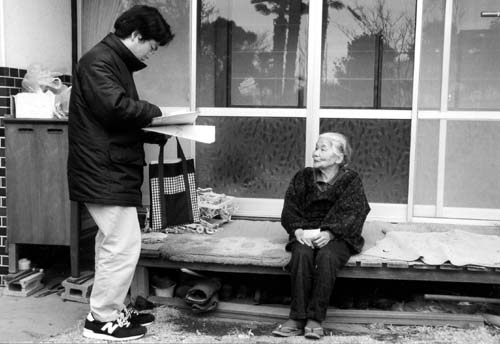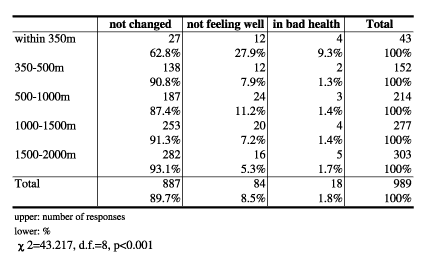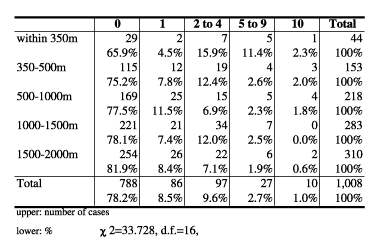 |
|
A survey assistant explains about a survey form of the effects of JCO criticality accident to the residents near JCO Co. on February 2002 (Naka-town, Ibaraki Prefecture. Photo by Noboru Kobayashi)
|
Three years have passed since the JCO criticality accident occurred on 30 September 1999. This article reviews results of the second field survey of Tokai-mura (Tokai Village) and Naka-machi (Naka Town) residents, carried out by the JCO Criticality Accident Comprehensive Assessment Committee in February 2002, and summarizes the current status of trials concerning the JCO criticality accident that have not been covered since Nuke Info Tokyo 86.
The JCO accident left deep scar
Citizens' Nuclear Information Center and the Japan Congress Against the A- and H- Bombs together organized the 'JCO Criticality Accident Comprehensive Assessment Committee' in 1999 and issued a report in September 2000 (See NIT 80). The Committee has been supported by the TOYOTA foundation in assessing the JCO accident since November 2001. In February 2002, more than two years after the September ‘99 accident, the JCO Committee members carried out a second field survey of Tokai Village and Naka Town residents.
The survey was carried out as a part of a series of research surveys begun in February 2000, and which have been led by Koichi Hasegawa, a professor of environmental sociology at the Graduate School of Arts and Letters, Tohoku University, and Yuko Takubo, an assistant professor of sociology at the College of Environmental and Disaster Research, Fuji Tokoha University. The aim of the surveys is to examine current health condition of the residents, the effects of the accident on their daily activities, and their opinions regarding nuclear power.
As a result of this survey, 1,008 questionnaires were completed from 535 households. The recovery rate of 77 percent from the sample households indicates keen interests among local residents about this issue. Prof. Hasegawa reported on the results and analysis of the survey in Tokai Village in April and in Tokyo in May.
The results of the survey show that those who have been suffering from mental and physical complaints have increased as compared to 2 years ago, whose results were more than anticipated, and it was found to be statistically significant that those living closer to the accident site tended to claim higher rates of abnormalities (Table 1 and Table 2). 25 percent of the participants who have received medical diagnosis check-ups by Ibaraki Prefecture reported that their anxiety and fear have not been resolved, and 64 percent of them still had concerns for the effect that the radiation may still have on them.
76 percent of them indicated a negative attitude toward the installation of additional nuclear facilities in Tokai Village. 46 percent of them opposed the hosting of the ITER (International Thermonuclear Experimental Reactor) in Naka Town, while 24 percent favors hosting the ITER project. In addition, more than half of the participants replied negatively to the question suggesting that they would rather not talk about topics relating the JCO accident and nuclear power. Although the JCO criticality accident left local residents with deep scars on the one hand, the opinion survey enlightens on how the accident has affected them and in what way the community of this area has changed; i.e. it can be seen that they have begun an open discussion regarding nuclear power among themselves.
Table 1. Correlation between distance from the JCO site and the awareness of physical abnormalities

Table 2. Correlation between distance from the JCO site and the number of cases who have physical abnormalities

The ruling on the JCO trial will be delivered next spring
On April 23, 2001, the first JCO public trial was held at Mito district court, where the public prosecutor described how the JCO relentlessly continued its operation, resulting in the death of two of their staff. Since then several hearings have been held to question witnesses. Mr. Yokokawa, one of the workers at the scene, testified in February and the testimony of five defendants' were followed. The hearings were completed in June. It is expected that the prosecutor's as well as the defendants' final speech and recommendation for punishment for the accused will be made at Mito district court on September 2 and October 21 respectively. A ruling in this case is expected to be handed down at the end of this fiscal year (next spring).
The trial of the JCO case was taken place after each defendant confirmed and agreed to the basic facts of the indictment. Defendants claimed that various factors, along with an error made by the JCO, were involved in the cause of the accident. It is known that the JCO conversion building where the incident took place passed a safety inspection in 1984, fifteen years before the accident. However, the inspection was very superficial, and this is thought to be one element in the cause of the accident. It was revealed for the first time in the course of the trial that the appointed safety inspector from the Science and Technology Agency (STA) had been contracted out from Japan Nuclear Cycle Development Institute (JNC), formerly the Power Reactor and Nuclear Fuel Development Corporation (PNC), which had submitted an order for uranium processing from JCO. It was also stated during the trial that the PNC repeatedly demanded that the JCO should carry out rush jobs for them.
Since the PNC and the STA have not been charged with any crime for this trial, their responsibilities have not been fully unveiled. In particular, there has never been any official investigation of the members of the Committee on Examination of Nuclear Fuel Safety in the Nuclear Safety Commission (NSC), which approved JCO's safety inspection, during the session of the Special Committee on Investigation of Nuclear Accident and Failures in the NSC and during the criminal trial.
It was extremely regrettable that human relationships between the PNC and the NSC, and a detailed account of how and why a 'precipitation tank' was used in the JCO factory, have never been uncovered.
With regard to the economic damage caused by the accident, a fermented soybean production company has filed a suit, seeking 18 billion yen compensation against JCO. A fish retailing company and a marine products company have brought cases to seek reparations of 56 million yen and 80 million yen respectively. In September 3 of 2002, three local residents appealed to a court for compensation for damage to their health. All the trials are currently ongoing.
The JCO Criticality Accident Comprehensive Assessment Committee is planning to issue an interim report (in Japanese) in September 2002. (The final report is expected to be issued in the autumn of 2003). The interim report will include the committee members' reports on the status of the trials mentioned above, the results of the field survey of local residents, and problems associated with disaster prevention measures.
Return to NIT 91 Contents

